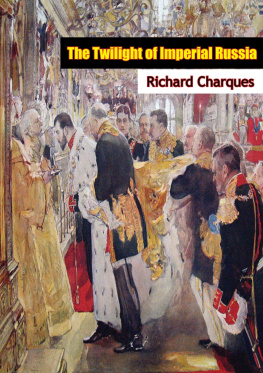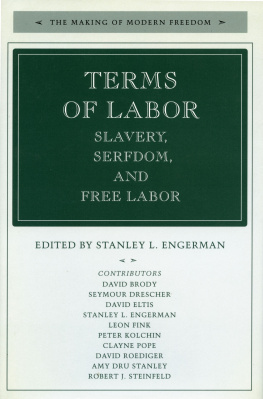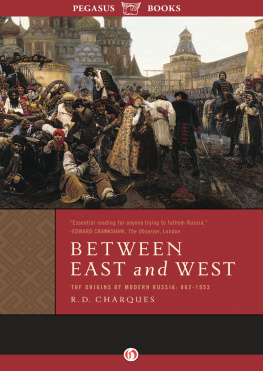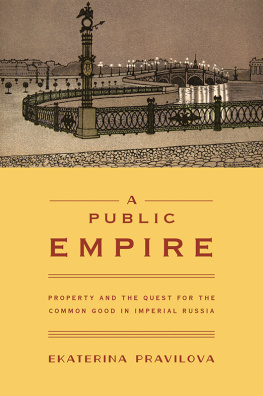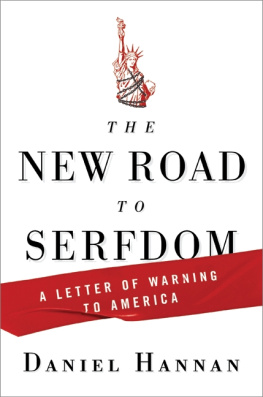Stites - Serfdom, Society, and the Arts in Imperial Russia
Here you can read online Stites - Serfdom, Society, and the Arts in Imperial Russia full text of the book (entire story) in english for free. Download pdf and epub, get meaning, cover and reviews about this ebook. year: 2005, publisher: YaleUP, genre: Home and family. Description of the work, (preface) as well as reviews are available. Best literature library LitArk.com created for fans of good reading and offers a wide selection of genres:
Romance novel
Science fiction
Adventure
Detective
Science
History
Home and family
Prose
Art
Politics
Computer
Non-fiction
Religion
Business
Children
Humor
Choose a favorite category and find really read worthwhile books. Enjoy immersion in the world of imagination, feel the emotions of the characters or learn something new for yourself, make an fascinating discovery.

- Book:Serfdom, Society, and the Arts in Imperial Russia
- Author:
- Publisher:YaleUP
- Genre:
- Year:2005
- Rating:3 / 5
- Favourites:Add to favourites
- Your mark:
- 60
- 1
- 2
- 3
- 4
- 5
Serfdom, Society, and the Arts in Imperial Russia: summary, description and annotation
We offer to read an annotation, description, summary or preface (depends on what the author of the book "Serfdom, Society, and the Arts in Imperial Russia" wrote himself). If you haven't found the necessary information about the book — write in the comments, we will try to find it.
Stites: author's other books
Who wrote Serfdom, Society, and the Arts in Imperial Russia? Find out the surname, the name of the author of the book and a list of all author's works by series.
Serfdom, Society, and the Arts in Imperial Russia — read online for free the complete book (whole text) full work
Below is the text of the book, divided by pages. System saving the place of the last page read, allows you to conveniently read the book "Serfdom, Society, and the Arts in Imperial Russia" online for free, without having to search again every time where you left off. Put a bookmark, and you can go to the page where you finished reading at any time.
Font size:
Interval:
Bookmark:
Serfdom, Society, and the Arts in Imperial Russia
Published with assistance from the Annie Burr Lewis Fund.
Published with assistance from the Mary Cady Tew Memorial Fund.
Copyright 2005 by Richard Stites.
All rights reserved.
This book may not be reproduced, in whole or in part, including illustrations, in any form (beyond that copying permitted by Sections 107 and 108 of the U.S. Copyright Law and except by reviewers for the public press), without written permission from the publishers.
ISBN: 0-300-10889-3
Set in Sabon type by Keystone Typesetting, Inc.
Printed in the United States of America by Sheridan Books.
A catalogue record for this book is available from the Library of Congress and the British Library.
The paper in this book meets the guidelines for permanence and durability of the Committee on Production Guidelines for Book Longevity of the Council on Library Resources.
10 9 8 7 6 5 4 3 2 1
In memory of Reginald Zelnik (1936-2004), beloved friend, colleague, human being
I have benefited a great deal from the generosity of donors over the years spent on this book. I thank the Fulbright Program for an award in 1995; the National Endowment for the Humanities for its fellowship in 1997-8 and for the Summer Institute on Art and Artifact in Russian History in St. Petersburg, organized by George Munro and Alison Hilton in 1992; the Social Science Research Council for financing, Jane Burbank for organizing, and the University of Iowa, Portland State University, and the Kennan Institute for hosting, three seminal conferences on Imperial Russia; IREX (the International Research and Exchanges Board) for an Academy of Science Fellowship in Moscow and St. Petersburg in 1997-98, one of a long chain of IREX awards supporting my work; the Georgetown University Graduate School, School of Foreign Service, Provosts Office, and Center for Eurasian, Russian, and East European Studies for innumerable research grants.
The Public Library of the Performing Arts at Lincoln Center in New York offered up its rich resources. In Washington, I thank the staffs of the Georgetown University Library, the Library of Congress Music and Performing Arts Division, and the Hillwood Museumparticularly Kristen Regina, Karen Kettering, and Anne Odom. The bright young Georgetown freshman Katherine Magalif helped me check sources during the final stages of the book and David Hagen made the pictures.
The bulk of the research was carried out in Moscow, St. Petersburg, a few provincial towns in Russia, and Helsinki. It would be superfluous to list all the archivists and librarians in the Russian cities, but I heartily thank them for their patience and industry. Special recognition however is in order: in Moscow, to Vitold Petyushenko, Research Director of the Tretyakov Gallery; Olga Butkova and Kirill Razlogov for my backstage tour of the Maly Theater; Anya Salnykova for the endless stream of books; and the guide to the Ostrovsky House-Museum. In St. Petersburg, I am indebted to Elena Barkhatova of the print and photography collection of the Russian National Library; Neli and Vasily Kuznetsov of the recordings collection at the Rimsky-Korsakov Conservatory for many hours of listening to and copying obscure music; Pavel Lyssakov and Andrei Tolshin for a backstage tour of the Alexandrinsky Theater; Yuliya Shkitina for an inside tour of the Academy of Arts; and Liya Yangulova for copying much-needed books. At the Russian Museum, Evgeniya Petrova, Irina Karaski, Raya Dashkina, Elena Stolbova, Kira Mikhailova, and Ekaterina Shilova showed me how to unlock the treasures stored in the attic of that great museum and to view a Russia-in-pictures rarely seen on museum walls.
In Smolensk, thanks go to the archivists, librarians, local studies people, and faculty assembled for an international conference by Catherine Evtuhov, Boris Gasparov, and Andrew Wachtel; in Novospasskoe, Smolensk Oblast, to the guide at the Glinka manor house museum; and in Kursk to Alexander Reprintsev and especially Tatyana Alentieva for revealing to me more of the wonders of provincial Russian life in Tula, Orl, Kursk, the Korennaya Monastery, Voronezh, and other sites connected with this book.
The Slavonic Library in Helsinki, Finland, has been my scholarly base each summer and several winters over the last twenty-five years. Its nearly complete collection of nineteenth-century journals on open shelves a few feet from the readers desks, its enormous collections, its machine-like efficiency, and its superbly accommodating staff make it the best library in the world outside Russia for prerevolutionary Russian studies and much else. I salute Irina Lukka, Maire Aho, Jarmo Suonsyrja, Sara Talasniemi, Eila Tervakko, and Leena-Riita Peltola for their incomparable services. I have gained much also from the Finnish National Gallery and the White Hall from their periodic shows of Russian art; and from the citys art, music, and theater libraries, with a special thanks to Liisa Byckling for theatrical expertise. At Helsinki Universitys Renvall Institute of History and Area Studies, my second home for many years, I thank Julia Azbel, Elena Hellberg-Hirn, Tuomas Lehtonen, Arto Luukkanen, Timo Vihavainen, Mikko Ylikangas, and Pirko Hautamaki. Most of all I cherish the friendship and support of Natalia Baschmakoff of Joensuu University.
Just as rehearsals are mandatory in theater, try-out talks can help shape and refine ideas for a book. I was lucky enough to present some of them in North America at Brown, Harvard, Johns Hopkins, Toronto, Brock, Grand Valley, and Miami of Ohio universities, the University of Southern California, and the Hillwood Museum; and in Europe at the Renvall Institute, the Baltic and East European Graduate School in Sdertorn (Sweden), the European University of St. Petersburg, Joensuu University in Finland, Cambridge University, and the State University of Kursk.
Good friends have supplied me with information, contacts, manuscripts, and CDs to feed my interests: Steven Marks, David Schimmelpenninck van der Oye, Tanya Stites, Hubertus Jahn, Abraham Ascher, Jeffrey Burds, David Moon, Fred Skinner, Paul Heineman, Andrew Wachtel, Lindsey Hughes, David Ransel, Douglas Smith, and Stuart Campbell. Scholars too numerous to mention have shared their unpublished dissertations and other materials listed in the bibliography. Priscilla Roosevelt, Boris Gasparov, Alison Hilton, and Murray Frame by their wisdom, learning, and close reading of my book, have added immensely to its value, as has Gavin Lewis for Yale University Press. Personal thank-yous can really get out of hand in a preface. I wish I could say a few words about my cat Blackie, but my publishers wont allow it. So I thank with all my heart my daughter Sasha; my sons Tod, Tom, and Andrei and his wife Holly Stevens; and, in addition to those mentioned above, Harley Balzer, Donald Duffy, Abbott Gleason, Ray Hanna, Brendan Humphreys, Daniel Orlovsky, Tom Quinn, Claus Westmeier, and the late Reginald Zelnik; the crowd at the Sea Horse in Helsinki and Martins Tavern and Cafe Milano in Georgetown: the old gang from the Kibbutz on Maneesikatu; and, most of all, the incomparable Peter Dunkley, David Goldfrank, Amy Leonard, and Howard Spendelow.
Note: for clarity and economy, I have used the now-out-of-use term actress. For variety I translate dvoryanstvo as both gentry and nobility and use the less-than-ideal Gentry Club for Dvoryanskoe Sobranie. In the text, Russian words are transliterated in a reader-friendly mode, but in a more scholarly way for the notes. The dates are all Old Style, thus two weeks behind the Western calendar in the nineteenth century.
In this book a historian takes a look at the arts; or better, a historian looks at the broad canvas on which societyits structures, practices, mentalitiesinteracted with the arts. Historians do different things from musicologists, art historians, and theater scholars; or at least we try. Linking creative expression to society is hardly a novel venture. Literary scholars of Russia have worked this vein with brilliant results. But then, print culture is only one form of expression. In a still largely illiterate servile Russia, its resonance was demographically slightalthough its filter effect over the generations has been enormous. If we look for lower-class participation in culture through the lens of published fiction, we will have to squint. Broadening the lens to include art, music, and theater catches the serf violinist, the cook-turned-ballerina, the small-town painter, the actor from the urban depths. Thousands of men and women got their lives entwined with Mozart and Molire, Ostrovsky and easel painting. Where are they to be found in standard accounts of Russian history?
Next pageFont size:
Interval:
Bookmark:
Similar books «Serfdom, Society, and the Arts in Imperial Russia»
Look at similar books to Serfdom, Society, and the Arts in Imperial Russia. We have selected literature similar in name and meaning in the hope of providing readers with more options to find new, interesting, not yet read works.
Discussion, reviews of the book Serfdom, Society, and the Arts in Imperial Russia and just readers' own opinions. Leave your comments, write what you think about the work, its meaning or the main characters. Specify what exactly you liked and what you didn't like, and why you think so.


